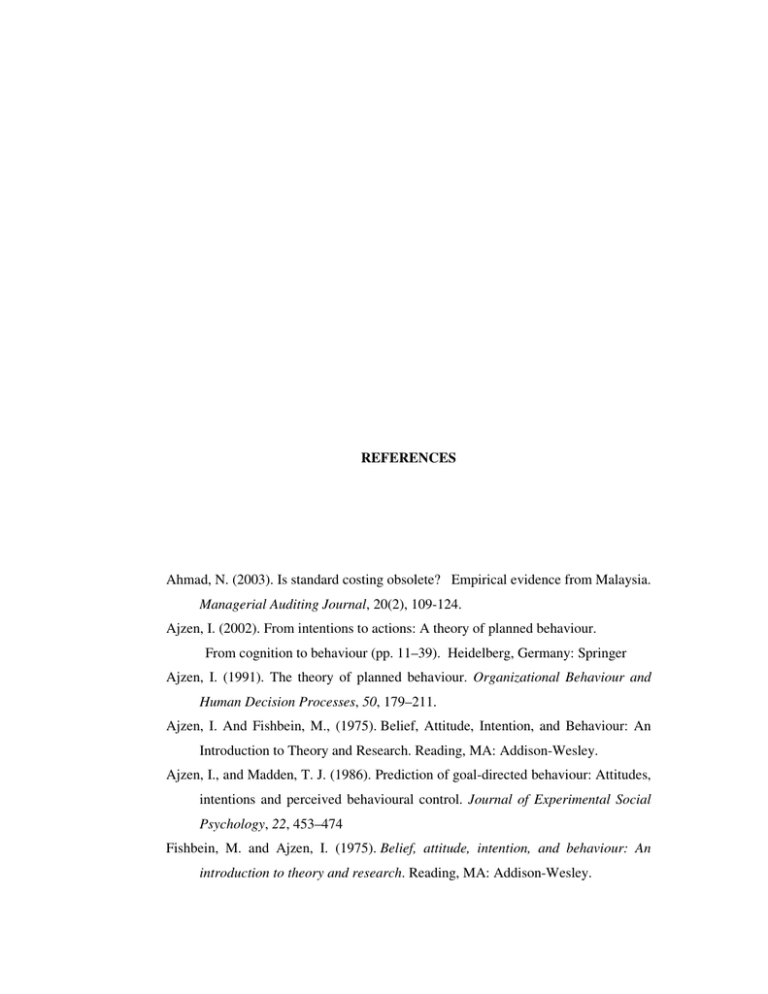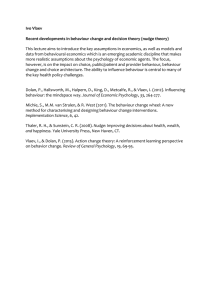Ahmad, N. (2003). Is standard costing obsolete? Empirical... , 20(2), 109-124.
advertisement

REFERENCES Ahmad, N. (2003). Is standard costing obsolete? Empirical evidence from Malaysia. Managerial Auditing Journal, 20(2), 109-124. Ajzen, I. (2002). From intentions to actions: A theory of planned behaviour. From cognition to behaviour (pp. 11–39). Heidelberg, Germany: Springer Ajzen, I. (1991). The theory of planned behaviour. Organizational Behaviour and Human Decision Processes, 50, 179–211. Ajzen, I. And Fishbein, M., (1975). Belief, Attitude, Intention, and Behaviour: An Introduction to Theory and Research. Reading, MA: Addison-Wesley. Ajzen, I., and Madden, T. J. (1986). Prediction of goal-directed behaviour: Attitudes, intentions and perceived behavioural control. Journal of Experimental Social Psychology, 22, 453–474 Fishbein, M. and Ajzen, I. (1975). Belief, attitude, intention, and behaviour: An introduction to theory and research. Reading, MA: Addison-Wesley. Beattie, Nick and Lehmann, Guenter (1994). ‘Special Places: The Nature of Urban Space and its Significance’. Chapter 5 in Johnson, Louise C. (Ed.). 1994. Suburban Dreaming: An Interdisciplinary Approach to Australian Cities. Deakin University Press: Melbourne. Bell, Paul A; Greene, Thomas C; Fisher, Jeffrey D; and Baum, Andrew. (1996). Environmental Psychology. 4th Edition. Harcourt Brace College Publishers: Sydney. Brebner, John. (1982). Environmental Psychology in Building Design. Applied Science Publishers: London. Cadman, David and Payne, Geoffrey (1990). The Living City: Towards a Sustainable Future. Routledge: New York. Canter, David and Stringer, Peter. (1975). Environmental Interaction: Psychological Approaches to our Physical Surroundings. Surrey University Press: London. Canter, David. (1977). the Psychology of Place. The Architectural Press: London. Carr, S., Francis, M., Rivilin, L.G. and Stone, A.M. (1992). Public Space. Cambridge: Cambridge University Press. Carr, S., M. Francis, L.G. Rivlin and A.M. Stone (1992) Public Spaces. Cambridge: Cambridge. Cavana, R. Y., Delahaye, B.L., Sekaran, U. (2001). Applied Business Research: qualitative and quantitative methods. 3rd ed. John Wiley and Sons, NY. Christian, J., and Abrams, D. (2003). The effects of social identification, norms and attitudes on use of outreach services by homeless people. Journal of Community and Applied Social Psychology, 13, 138–157. Dewey, J. (1925). Experience and nature. Chicago: Open Court Publishing. Engwicht, D. (1999) Street Reclaiming: Creating Livable Streets and Vibrant Communities. Philadelphia, PA: New Society Publishers. environments that work. San Francisco: Jossey-Bass Fekadu, Z., and Kraft, P. (2002). Expanding the theory of planned behaviour: The role of social norms and group identification. Journal of Health Psychology, 7, 33–43. French, Jere Stuart. 1978. Urban Space: A Brief History of the City Square. Kendall Hunt: Iowa. Fishbein, M. (1966). The relationships between beliefs, attitudes, and behavior. In S. Feldman (Ed.), Cognitive consistency (pp. 199–223). New York: Academic Press Gehl, J. (1987), Life Between Buildings: Using Public Space, Van Nostrand Reinhold, New York, Gifford, Robert. 2002. Environmental Psychology: Principles and Practice. 3rd Edition. Optimal Books: Canada. Higher Education Research and Development, 19(2), 221-236. Grove, S. And Burns, N. 1993. The practice of nursing research: conduct, critique and utilization. W.B.Saunders: Philadelphia, Pennsylvania, USA. Hair, J.F. Jr., Anderson, R.E., Tatham, R.L., and Black, W.C. (1998). Multivariate Data Analysis. Upper Saddle River, NJ: Prentice Hall. Hulland, N. (1993). Construct validity of an objective (entropy) categorical measure of diversification strategy. Strategic Management J. 14 215–235. Insel, Paul N. and Lindgren, Henry Clay. (1978). Too Close for Comfort: The Psychology of Crowding. Prentice Hall: New Jersey. Jakle, John A.; Brunn, Stanley; and Roseman, Curtis C (1976). Human Spatial Behaviour: A Social Geography. Duxbury Press: Massachusetts. Jamieson, P., et al. (2000). Place and space in the design of new learning environments. Johnson, C., and Lomas, C. (2005). Design the learning space. Educause, 16-28. Kaiser, F. G., and Gutscher, H. (2003). The proposition of a general version of the theory of planned behaviour: Predicting ecological behaviour. Journal of Applied Social Psychology, 33, 586–603. Kallgren, C. A., Reno, R. R., and Cialdini, R. B. (2000). A focus theory of normative conduct: When norms do and do not affect behaviour. Personality and Social Psychology Bulletin, 26, 1002–1012. Krejcie, R. V., and Morgan, D. W. (1970). Determining sample size for research activities. Educational and Psychological Measurement, 30, 607-610 Krieger. Latan!e, B., and Liu, J. H. (1996). The inter subjective geometry of social space. Journal of Communication, 46(4), 26–34. Leedy, P. D., and Ormrod, J. E. (2005). Practical research: Planning and design (8th Ed.). Upper Saddle Levy-Leboyer, Claude. (1982). Psychology and the Environment. Sage: London. Lombardi, M. (2005). Standing on the plateau looking forward: The Croquet Project. Low, Setha M. (1987). ‘Developments in Research Design, Data Collection and Analysis: Qualitative Methods’. Chapter 11 in Zube, Ervin H and Moore, Gary T. (Eds.). 1987. Mackenzie and Jurs. (1993). Theory of reasoned action/theory of planned behaviour, University. Madanipour, A. (2003). Public and Private Space of the City. London: Routledg Marmot, A. (2008). Spaces for learning. Paper presented at the Scottish Funding. McAndrew, Francis T. (1993). Environmental Psychology. Brooks/Cole: California. Mehrabian, Albert. (1976). Public Places and Private Spaces. Basic Books: New York. Mertes, Karen R. (1996). "Calibration of the CHECKPOINT Model to the Space and Missile Systems Center (SMC) Software Database (SWDB)." Unpublished masters thesis. Dayton, OH, Air Force Institute of Technology. Miller, J.S. (2005). Problem-based learning in Organizational Behaviour class: Solving students’ real problems. Journal of Management Education, 28(5): 578-590. Minami, H., and Tanaka, K. (1995). Social and environmental psychology: Transaction between physical space and group- dynamic processes. Environment and Behaviour, 27, 43–55. Moos, R. (1986). The human context: Environmental determinants of behaviour. Malabar, FL. Moscovici, S. (1988). Notes towards a description of social representations. European Journal of Social Psychology, 18, 211–250. Mossop, Elizabeth and Walton, Paul . (2001). City Spaces: Art and Design. Craftsman House: St Leonards. Nasar, Jack L. (2004). The Evaluative Image of the City. Sage Publications: California. NY Pomeranz, David. (1980). ‘Environmental Psychology’. Chapter 3 in Krasner, Leonard. (Ed.). 1980. Environmental Design and Human Behaviour: A Psychology of the Individual in Society. Pergamon Press: Sydney. Proshansky, H. M., Fabian, A. K., and Kaminoff, R. (1983). Place- identity: Physical world socialization of the self. Journal of Environmental Psychology, 3, 57–83. River, NJ: Prentice Hall. Salant, P., and Dillman, D. A. (1994). How to conduct your own survey. New York: John Wiley and Sons, Inc. Sheppard, B.H.; Hartwick, J. and Warshaw, P.R (1988). The theory of reasoned action: A meta-analysis of past research with recommendations for modifications and future research. Journal of Consumer Research, 15, 325– 343. Sibley, C. G., and Liu, J. H. (2003). Differentiating active and passive littering: A two-stage process model of littering behaviour in public spaces. Environment and Behaviour, 35, 415–433. Sibley, C. G., Hunt, M., and Harper, D. N. (2001). Identifying cross-cultural differences in the effectiveness of an information and free child seat rental program. Behaviour Change, 18, 224–235. Sommer, Robert. (1984). Social Design: Creating Buildings with People in Mind. Prentice Hall Inc: New Jersey. Speller, Gerda. (2006). ‘A Place of my Own’ in Green Places. Issue 26, March 2006, p.p. 18-20. Stedman, R. C. (2002). Toward a social psychology of place: Predicting behaviour from place-based cognitions, attitude, and identity. Environment and Behaviour, 34, 561–581. Strange, C., and Banning, H. (2002). Educating by design: Creating campus learning. Terry, D. J., and Hogg, M. A. (1996). Group norms and the attitude behaviour relationship: A role for group identification. Personality and Social Psychology Bulletin, 22, 776–793. Terry, D. J., Hogg, M. A., and White, K. M. (1999). The theory of planned behaviour: Self-identity, social identity and group norms. British Journal of Social Psychology, 38, 225–244. University Press. Vaske, J. J., and Kobrin, K. C. (2001). Place attachment and environmentally responsible behaviour. Journal of Environmental Education, 32, 16–21. Veitch, Russell and Arkkelin, Daniel. (1995). Environmental Psychology: An Interdisciplinary Perspective. Prentice Hall: New Jersey. Vorkinn, M., and Riese, H. (2001). Environmental concern in a local context: The significance of place attachment. Environment and Behaviour, 33, 249–263. Whyte, W. (1980). The social life of small urban spaces. Washington, DC: The Conservation Foundation. Winett, Richard A. (1987). ‘Empiricist-Positivist Theories of Environment and Behaviour: New Directions for Multilevel Frameworks’ Volume 1. Plenum Press: New York. Winikoff, Tamara (2000). Places Not Spaces: Place making in Australia. Envirobook Publishing: Sydney.



